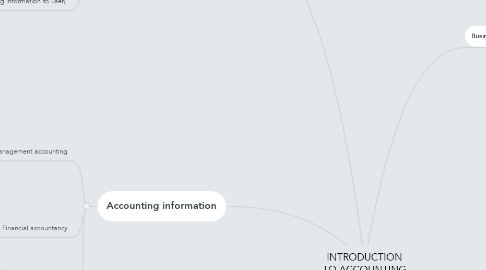
1. Limited company (Cty TNHH)
1.1. Difference to SD/ Partnership
1.1.1. separate legal entity
1.1.2. proprety belong to company
1.1.3. tranferable shares
1.1.4. no maximum amount of shares
1.1.5. floating security
1.2. Users (providing information to user)
1.2.1. of information from company
1.2.1.1. investors
1.2.1.2. employees
1.2.1.3. managers
1.2.1.4. lenders
1.2.1.5. customers
1.2.1.6. suppliers
1.2.1.7. government
2. Accounting information
2.1. Management accounting
2.1.1. for internal manager
2.1.2. real time
2.1.3. no standards
2.1.4. depends on business
2.2. Financial accountancy
2.2.1. for external users (public)
2.2.2. based on standards
2.2.3. comparablility
2.3. System
2.3.1. provides information
2.3.2. usually computerised
3. Type of regulations
3.1. Principles based
3.1.1. Example: IFRS
3.1.2. based on conceptual framework
3.1.3. not defined "rule"
3.2. Rules based
3.2.1. Example: US GAAP
3.2.2. clear set rules
3.3. Why regulate?
3.3.1. compare information
3.3.2. useful to users
3.3.3. stipulate information required
3.3.4. regulate behaviour
4. Business Entity (Thực thể kinh doanh)
4.1. Sold traders (Cty tư nhân)
4.1.1. Owed/ Managed by 1 person
4.1.2. May have employees
4.1.3. Any losses borne by owner
4.2. Pros/Cons
4.2.1. Pros
4.2.1.1. Simple/ simple/ manageble
4.2.2. Cos
4.2.2.1. Unlimited liabilitiy/ Personal risk/ Rely on owner
4.3. Parnership
4.3.1. Two or more owner
4.3.2. Equally liable for losses
4.4. Pros/Cons
4.4.1. Pros
4.4.1.1. More resources/ People combine/ Work together/ Still take risk
4.5. Limited company
4.5.1. Business owned by shareholders
4.5.2. Only lose amount invested
4.5.3. managers run the business
4.6. Pros/Cons
4.6.1. Pros
4.6.1.1. Limited liability/ Tax efficient
4.6.2. Con
4.6.2.1. Admin/ Inflexible
5. Regulation
5.1. IFRS Foundation
5.1.1. Internation Financial Reporting Standards
5.1.2. What?
5.1.2.1. 22 trustees
5.1.2.2. governance
5.1.2.3. supervises IASB
5.1.3. Objectives
5.1.3.1. develope global standards
5.1.3.2. provides inf to users
5.1.3.3. & help investors decisions
5.2. IASB
5.2.1. International Accounting Standard Board
5.2.2. What?
5.2.2.1. issues accounting standards
5.2.2.1.1. IFRS
5.2.2.2. 15 members
5.2.2.3. objectives the same as foundation
5.3. National bodies
5.3.1. work with IASB
5.3.2. need their co-operation
5.3.3. choose implement IFRS
5.3.4. covergence
5.3.4.1. national standard
5.3.4.2. IFRS
